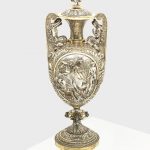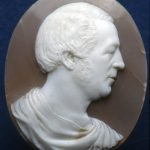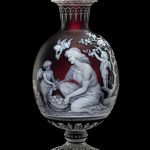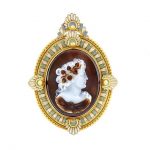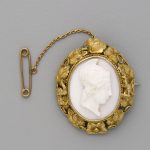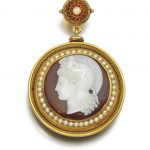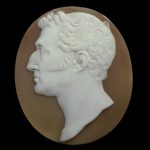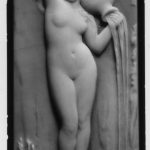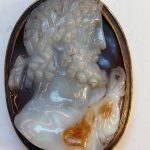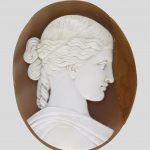Victorian Cameos Information. Queen Victoria reigned between 1837 to 1901 and Victorian fashions changed considerably during this era including those of Victorian cameos. Although this era is referred to as Victorian, this section contains information on cameos and cameo glass during this era from other countries as well as those under the rule of Queen Victoria in order to show as many different styles as possible.
Queen Victoria loved cameos and by the late 19th century many cameo brooches were massed produced. Upon her widowhood, Queen Victoria commissioned a series of bejeweled cameos in onyx with a double portrait of her and her late husband to give as badges to members of the Royal Order of Victoria and Albert. Reference: The Study.
During the early years of her reign, Renaissance Revival was the fashion. This could be seen not only in cameo jewellery but in household items such as vases as well. By the late 19th century this fashion was in decline and the Art Nouveau movement began.
After the death of Albert the country went into mourning and black became a favourite colour of the nation and remained so until her death in 1901.
An impressive Victorian parcel-gilt silver cup and cover by Hancocks & Co, London 1872 Vase form, the cover surmounted by the figure of Nike, the two handles supported by twin-tailed mermaids, the body with two cameo scenes, the first of Perseus rescuing Andromeda, the other of the foundation of Athens with Athena and the olive tree and Neptune creating a spring by thrusting his trident into the ground, the whole richly embossed and chased with floral and foliate ornament, length 86.5cm, weight 236oz.
Sold for £ 22,500 inc. premium at Bonhams in 2018
Cameo; shell; profile bust of a man, possibly Horatio Greenough circa 1850.
Reference: © The Trustees of the British Museum
A THOMAS WEBB & SONS CAMEO GLASS VASE, ‘AUTUMN’ CIRCA 1900, TITLED ON THE UNDERSIDE, ‘AUTUMN’ DESIGNED BY AND SIGNED IN INTAGLIO GEO.(RGE) WOODALL The frosted dark brown glass wall overlaid in opaque white, wheel-engraved with a classically draped maiden harvesting apples and other fruit, aided by three putti, a sheaf of wheat by her feet 10 5/8 in. (27 cm.) high
Sold for USD 50,000 at Christies in 2018
Antique Gold, Hardstone Cameo and Enamel Pendant-Brooch Centering one oval brown and white agate cameo depicting the profile of a lady, approximately 33.0 x 26.0 mm., surrounded by green and white enamel plaques, quartered by shell plaques, edged by twisted gold wire and beading, circa 1880, minor enamel loss, approximately 13.2 dwts.
Cameo: nice carving, translucent, good luster. Minor enamel loss and pitting. Several minor dings on reverse of gold frame. 2 5/16 x 1 3/4 inches.
Sold for $2,500 (includes buyer’s premium) at Doyle New York in 2018
A mid Victorian gold shell cameo brooch. Of oval outline, carved to depict putti adorning a goat with flowers, amongst classical ruins, to the scrolling foliate cross motif surround. Cameo signed with initials PL. Length 6.6cms. Weight 24.3gms. CONDITION Overall condition good. Some surface scratches, slight discolouration and minor dents in keeping with general age and wear. Cameo has a fine crack visible to the reverse, approximately 1.8cms long. Scratch marks to the reverse and mark ‘as.as.’
Sold for £480 at Fellows in 2018
Cameo by George W. Jamison (American, New York 1810–1868 Yonkers, New York) Metalwork by William Rose (active 1839–50) ca. 1835
The helmet-conch-shell cameo with a bust of Andrew Jackson, cut in about 1835 by George W. Jamison, is an elegant tribute to the seventh president. Reflecting the “cameo fever” that first swept Europe in the late eighteenth century, it is inscribed with Jackson’s oft-quoted slogan, THE UNION / IT MUST AND / SHALL BE / PRESERVED.
Reference: The Metropolitan Museum of Art
Gold brooch set with an Italian shell cameo, shaded pale pink featuring a profile of Roman Centurion. The ornate gold frame features small figures of an emu and kangaroo flanking either side of the cameo centrepiece complimented by floral motifs, made in Australia about 1870. A small safety chain is attached to the top of the brooch with a fastening pin on the end.
This brooch is a fine example of the jewellery produced towards the end of the gold rushes in eastern Australia. Gold rushes continued in Australia into the 1870s although the finds were smaller and the level of excitement had begun to diminish. This combined with a gradual change in fashion led to the production of brooches and bracelets that were less massive and with a more restrained use of indigenous motifs than at the height of the gold rush in the 1850s and 1860s. Often the only hint at Australian origin would be found in the tiny kangaroos and emus incorporated into folate frames embracing an Italian cameo shell or micromosaic. The mainstream of locally made jewellery at this time concentrated on the use of local gemstones in designs that followed European fashions.
Reference: Brilliant, Australian Gold and Silver, 1851-1950, edited by Eva Czerniz-Ryl, Powerhouse Publishing, Sydney Australia, 2011
Museum Applied Arts and Sciences
Agate cameo pendant brooch, Luigi Rosi, 1870s Set with a circular agate cameo depicting Minerva, within a seed pearl and open work border in the Etruscan revival style, suspended from a fine rope work and seed pearl floral motif, detachable pendant fitting, signed L. Rosi, Roman assay mark.
Sold for 3,250 GBP at Sothebys in 2018
Cameo, bullmouth helmet shell, of Arthur Wellesley, Duke of Wellington, by Raffaele Pistrucci, England, ca. 1840
Reference: © Victoria and Albert Museum
Cameo after “La Source,” by Ingres
Carved cameo after the painting “La Source” by Ingres. François was a pupil of Bonnat and Chapu. From 1867 he exhibited several cameos in various stones and at least one statuette at the Salon in Paris. The cameos included subjects such as “Liberty,” “Saint George,” and “Prometheus,” as well as several scenes featuring Venus. He was an officer of the Legion d’Honneur and some of his work can be found in the Luxembourg Museum, Paris.
Reference: The Walter Art Museum
